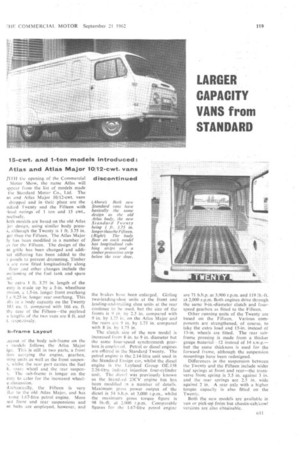LARGER CAPACITY VANS from STANDARD
Page 121

If you've noticed an error in this article please click here to report it so we can fix it.
[lilt the opening of the Commercial Motor Show, the name Atlas will ippear from the list of models made the Standard Motor Co., Ltd. The as and Atlas Major 10/12-cwt. vans dropped and in their place are the ndard Twenty and the Fifteen with load ratings of 1 ton and 15 cwt., pectively.
loth models are based on the old Atlas jor design, using similar body presss, although the Twenty is 1 ft. 3.75 in. ger than the Fifteen. The Atlas Major ly has been modified in a number of ys for the Fifteen. The design of the nt grille has been changed and addila] stiffening has been added to the panels to prevent drumming. Timber :s arc now fitted longitudinally along floor and other changes include the osiiionine of the fuel tank and spare he extra 1 ft. 3.75 in. length of the enty is made up by a 5-in. wheelbase 2nsion, a 1.5-in, longer front overhang I a 9.25-in, longer rear overhang. This alts in a body capacity on the Twenty 181 Cu. ft. compared with 166 cu ft. the case of the Fifteen—the payload a lengths of the two vans are 8 ft. and t. espeutively.
b-frame Layout
_ayout of the body sub-frame on the ) models follows the Atlas Major ign. This is still in two parts, a front Lion carrying the engine, gearbox. :ring units as well as the front suspen1, whilst the rear part carries the fuel k. -;pare wheel and the rear suspen1. The sub-frame is longer on the enty to cater for the increased wheele dimension.
,teehanically, the Fifteen is very ilar to the old Atlas Major, and has same 1.67-litre petrol engine. More ,ust front and rear suspensions and nt hubs are employed, however, and
the brakes have been enlarged, Girline two-leading-shoe units at the front and leading-and-trailing shoe units at the rear continue to be used, but the size of the fronts is 9 in. by 2.5 in. compared with 9 in. by 1.75 in, on the Atlas Major and the rears are 9 in. by 1.75 in. compared with 8 in. by 1.75 in.
The clutch size of the new model is increased from 8 in. to 9 in. diameter but the same four-speed synchromesh gearbox is employed. Petrol or diesel engines are offered in the Standard Twenty. The petrol engine is the. 2.14-litre unit used in the Standard Ensign car, whilst the diesel engine is the Leyland Group 0E.138 2.26-litre indirect injection four-cylinder unit. The diesel was previously known as the StanclArd 23CV engine but has been modified in a number of details. Maximum gross power output of the diesel is 54 b.h.p. at 3,000 r.p.m., whilst the maximum gross torque figure is 98 lb.-ft. at 2.000 r.p.m. Comparable figures for the 1.67-litre petrol engine
are 71 b.h.p. at 3,900 r.p.m. and 119 lb.-ft. at 2,000 r.p.m. Both engines drive through the same 9-in.-diameter clutch and fourspeed gearbox as fitted to the Fifteen.
Other running units of the Twenty are based on the Fifteen, Various components are strengthened, of course, to take the extra load and 15-in, instead of 13-in, wheels are fitted. The rear sub' frame pressing is made from a thicker gauge enateria1---12 instead of 14 s.w.g.-but the same thickness is used for the forward frame, although the suspension mountings have been redesigned.
Differences in the suspension between the Twenty and the Fifteen include wider leaf springs at front and rear—the transverse front spring is 3.5 in. against 3 in. and the rear springs are 2.5 in. wide against 2 in. A rear axle with a higher torque capacity is also fitted on the Twenty.
Both the new models are available in van or pick-up form but chassis-cabjcowl versions are also obtainable.










































































































































































































































































































































